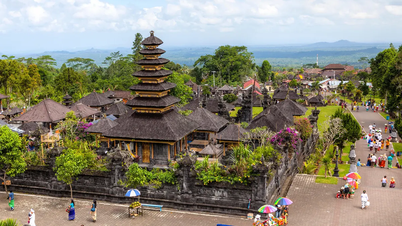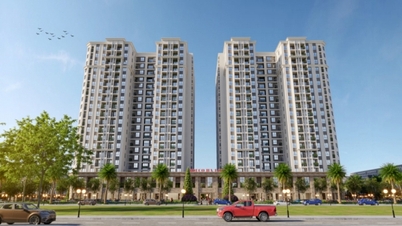Many famous tourist destinations such as Bali and Kyoto are overloaded with tourists, leading to negative consequences for the environment and people's lives.
Each year, Fodor's No List highlights destinations that stand out for their beauty and culture but are facing the problem of overtourism. These destinations often prioritize tourism over protecting the rights of their residents, leading to overcrowding, environmental damage, and rising prices. Fodor's is not calling for a boycott, but hopes to raise awareness and find solutions to protect the destination for future generations.
Here is a list of famous places to avoid in 2025.
Kyoto and Tokyo, Japan
Kyoto is facing the phenomenon of overtourism despite the city applying many measures such as installing surveillance cameras, setting up a luggage delivery system, erecting signs prohibiting harassment and taking photos of geisha. However, tourists often do not tend to learn the rules before traveling, so these strategies seem to be ineffective, requiring more radical solutions, according to Nippon.
According to the Japan National Tourism Organization (JNTO), international arrivals to Japan hit a record high of more than 3.2 million in July, surpassing the 3 million mark in March, April, May and June. The yen weakened, reaching its lowest level since the early 1990s, making travel to Japan more affordable.

In return, domestic tourism prices have risen sharply - hotel prices are 25% higher than before the pandemic. Ms. Wanping Aw, director of travel agency TokudAw Inc., commented that the high hotel prices have made it difficult for Japanese people to book rooms. In Kyoto, attractions such as Arashiyama, Kiyomizudera and Fushimi Inari are often overcrowded. She also said that famous food markets such as Tsukiji, Tokyo; Nishiki, Kyoto and Omicho, Kanazawa have lost their local identity because they prioritize selling to tourists at higher prices; food that suits tourists' tastes.
Bali, Indonesia
Bali’s provincial statistics agency said the island welcomed about 5.3 million international visitors in 2023, a sharp recovery from pre-pandemic levels but still lower than the 6.3 million in 2019. In the first seven months of the year, the number of foreign visitors reached 3.5 million, up 22% compared to the same period in 2023.
The recovery in tourism has boosted the economy but also put enormous pressure on Bali’s infrastructure. Once pristine beaches like Kuta and Seminyak are now littered with rubbish. According to the Bali Partnership, a waste management research alliance, the island generates 1.6 million tonnes of waste each year, more than 300,000 tonnes of which is plastic. However, only 48% is properly disposed of, 7% of plastic is recycled and 33,000 tonnes of plastic waste ends up in the environment each year.

Indonesia’s coastal water quality is under pressure from organic pollution, heavy metals and excess nutrients from domestic, industrial and agricultural wastewater. The Asian Development Bank says only 59% of the population has access to improved sanitation, adding to the pressure on the natural environment.
Dr. Marta Soligo from the University of Nevada, Las Vegas, criticized the “economic growth at all costs” mindset, noting that this approach prioritizes short-term profits at the expense of long-term sustainability. She said rising living costs, noise pollution, traffic congestion, and conflicts between tourists and local residents are on the rise in Bali.
Koh Samui, Thailand
Samui has long been a draw for tourists thanks to its luxury resorts and villas. Last year, the island welcomed 3.4 million visitors, reaching pre-pandemic levels, with a further 10-20% increase expected by 2024. But experts warn that the surge could exacerbate existing problems.
Currently, the island’s landfill contains 200,000 tons of waste, not to mention the uncontrolled development in the mountainous area. The island’s incinerator system is rarely used and most of the wastewater is still discharged directly into the sea due to lack of funding to operate the treatment plant.

Uncontrolled tourism development has also resulted in illegal villas and resorts, which pose a risk of landslides and have a negative impact on the marine environment. Dr. Kannapa Pongponrat Chieochan of Thammasat University said weak law enforcement and political interference have compounded the situation. The demand for construction workers to serve the growing number of tourists has also led to rapid internal migration, putting pressure on natural resources.
Mount Everest, Nepal
Adventure tourism in Nepal has grown exponentially since Tenzing Norgay and Edmund Hillary conquered Mount Everest 76 years ago. However, the influx of visitors to Sagarmatha National Park, especially the Everest Base Camp (EBC) trail, is causing serious problems.
The number of tourists has doubled in 25 years to about 58,000 a year, forcing small farming villages along the route to be converted into motels and hotels. An estimated 30 tons of human excrement and garbage litter the slopes, threatening the fragile ecosystem that cannot withstand the pressure of mass tourism.

Organizations like KEEP and Sagarmatha Next have called for limits on tourist numbers to protect the area and improve infrastructure, but the Nepalese government has yet to impose a specific limit. Instead, tourism agencies are eager to attract more visitors, despite concerns about pollution and cultural erosion in the region.
Europe
Many popular tourist destinations in Europe are facing a negative reaction from locals as international tourism increases. According to the European Tourism Commission, arrivals in the first quarter increased by 7.2% compared to before the pandemic, leading to overcrowding, affecting infrastructure, natural resources and the cost of living in these areas.

In Barcelona, people sprayed tourists with water and staged protests. Meanwhile, in the Canary Islands, tens of thousands took to the streets to protest mass tourism. Many places like Lisbon and Venice are under similar pressure as the number of short-term rentals skyrocketed, driving up house prices and forcing locals to leave their homes.
Amsterdam has implemented a number of measures to curb tourism, including banning large cruise ships from docking, reducing the number of river cruises and halting new hotel construction. However, the effectiveness of these measures remains to be seen.
Some other locations
Agrigento in Sicily, Italy - which is set to become the Italian Capital of Culture in 2025, is expected to attract large numbers of tourists. The region is facing a serious water crisis and the large number of visitors will put more pressure on the already limited water system.

The British Virgin Islands also faces many challenges in developing sustainable tourism as its heavy dependence on cruise tourism does not bring significant economic benefits to local people.
Kerala, India Uncontrolled tourism development is disrupting natural water flows and increasing the risk of landslides. About 60% of landslides in India between 2015 and 2022 occurred in Kerala.
Source




![[Photo] General Secretary To Lam attends the 8th Congress of the Central Public Security Party Committee](https://vphoto.vietnam.vn/thumb/1200x675/vietnam/resource/IMAGE/2025/10/4/79fadf490f674dc483794f2d955f6045)


![[Photo] Solemn opening of the 8th Congress of the Central Public Security Party Committee, term 2025-2030](https://vphoto.vietnam.vn/thumb/1200x675/vietnam/resource/IMAGE/2025/10/4/f3b00fb779f44979809441a4dac5c7df)
























![[Infographic] Notable numbers after 3 months of "reorganizing the country"](https://vphoto.vietnam.vn/thumb/1200x675/vietnam/resource/IMAGE/2025/10/4/ce8bb72c722348e09e942d04f0dd9729)
![[Photo] Bustling Mid-Autumn Festival at the Museum of Ethnology](https://vphoto.vietnam.vn/thumb/1200x675/vietnam/resource/IMAGE/2025/10/4/da8d5927734d4ca58e3eced14bc435a3)



























































Comment (0)